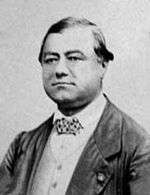Charles-Eugène Delaunay
| Charles-Eugène Delaunay | |
|---|---|
|
Charles-Eugène Delaunay | |
| Born |
9 April 1816 Lusigny-sur-Barse, France |
| Died |
5 August 1872 (aged 56) Cherbourg, France |
| Nationality | French |
| Fields | astronomy |
| Institutions | Paris Observatory |
| Known for | lunar motion studies |
Charles-Eugène Delaunay (9 April 1816 – 5 August 1872) was a French astronomer and mathematician. His lunar motion studies were important in advancing both the theory of planetary motion and mathematics.[1]
Life
Born in Lusigny-sur-Barse, France, to Jacques‐Hubert Delaunay and Catherine Choiselat,[2] Delaunay studied under Jean-Baptiste Biot at the Sorbonne. He worked on the mechanics of the Moon as a special case of the three-body problem. He published two volumes on the topic, each of 900 pages in length, in 1860 and 1867. The work hints at chaos in the system, and clearly demonstrates the problem of so-called "small denominators" in perturbation theory. His infinite series expression for finding the position of the Moon converged too slowly to be of practical use but was a catalyst in the development of functional analysis[3] and computer algebra.[4]
Delaunay became director of the Paris Observatory in 1870 but drowned in a boating accident near Cherbourg, France two years later.[3]
Honours
- Member of the Académie des Sciences, (1855)[5]
- Gold Medal of the Royal Astronomical Society, (1870)[6]
- His name is one of the 72 names inscribed on the Eiffel Tower.
References
- ↑ "Obituary: M. Charles E. Delaunay". MNRAS. 33: 203–209. February 1873. Bibcode:1873MNRAS..33..190.
- ↑ Hockey, Thomas (2009). The Biographical Encyclopedia of Astronomers. Springer Publishing. ISBN 978-0-387-31022-0. Retrieved August 22, 2012.
- 1 2 O'Connor & Edmund
- ↑ R. Pavelle, M. Rothstein and J. Fitch, "Computer Algebra", Scientific American, 245 (6), pp.102-113 (December 1981)
- ↑ [Anon.] (2001)
- ↑ Gold Medal Winners (PDF), Royal Astronomical Society, retrieved 4 November 2014
Bibliography
By Delaunay
- Delaunay, C.-E. (1874) [1850]. Cours élémentaire de mécanique (8th ed.).
- — (1870) [1853]. Cours élémentaire d'astronomie (5th ed.).
- — (1873) [1856]. Traité de mécanique rationnelle (4th ed.).
- — (1860). Théorie du mouvement de la lune. Vol. 1.
- — (1867). Théorie du mouvement de la lune. Vol. 2.
- — (1866). Ralentissement de la rotation de la terre.
- — (1867). Rapport sur les progrès de l'astronomie.
About Delaunay
- [Anon.] (2001) "Delaunay, Charles-Eugène", Encyclopaedia Britannica, Deluxe edition CD-ROM
- O'Connor, John J.; Robertson, Edmund F., "Charles-Eugène Delaunay", MacTutor History of Mathematics archive, University of St Andrews.
